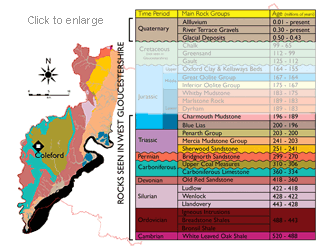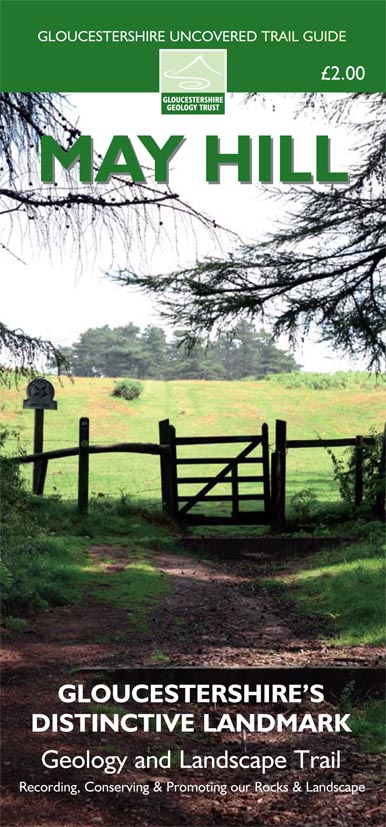Forest of Dean Geology
 The oldest rocks found in Gloucestershire outcrop to their greatest extent in the Forest of Dean and north-west Gloucestershire. The oldest rocks found in Gloucestershire outcrop to their greatest extent in the Forest of Dean and north-west Gloucestershire.
To the north of Dean, Precambrian and Lower Palaeozoic rocks can be found around the southern end of the Malvern Hills and include igneous rocks of the Malverns Complex, Cambrian Shales, Ordovician dolerite intrusions and Silurian limestones and shales.
The Forest of Dean lies between the valleys of the Rivers Severn and Wye, and its geology has greatly influenced the landscape, history, culture and economy of the area. Its appearance is that of a steep-sided, deeply dissected plateau, formed of a fractured, asymmetrical, synclinal basin and is composed of Upper Palaeozoic rocks from the Silurian, Devonian and Carboniferous periods.
The Silurian rocks are not widespread and generally limited to the area around May Hill and the southern end of the Malverns. They consist of coarse gritty sandstones at the base, overlain by mainly silty or calcareous mudstones and flaggy limestones. The limestones were deposited in a relatively shallow shelf sea but towards the end of the Silurian period, the region was affected by uplift from the Caledonian Orogeny, which resulted in a fall in sea level and a gradual change from marine to mostly terrestrial sedimentation, signifying the start of the Devonian Period.
During the Devonian, Britain formed part of a large continental mass called Laurussia and is often referred to as the "Old Red Sandstone Continent." Sedimentation commences with deposition of the Lower Old Red Sandstone, a sequence of sediments, predominantly fluvial in origin, deposited over broad alluvial plains by meandering river channels during semi-arid climatic conditions.
The rocks of the Middle Old Red Sandstone and base of the Upper Old Red Sandstone are missing in this region, the result of uplift during the final phase of the Caledonian earth movements and resulted in the gentle folding and erosion of the Old Red Sandstone. This period of erosion represents a break in the stratigraphic record and is referred to as the intra-Old Red Sandstone unconformity. Towards the end of the Devonian, sedimentation recommenced with the deposition of the Upper Old Red Sandstone, lying unconformably on the eroded Lower Old Red Sandstone.
The predominantly fluvial deposition of the Old Red Sandstone was terminated with the initiation of an extensive rise in sea level, marking the start of the Carboniferous Period. The early Carboniferous sea was clear and warm and supported a diverse range of marine organisms, such as corals, crinoids and brachiopods and led to deposition of the Carboniferous Limestone Series and a gradual change from fluvial to marine sedimentation. Another period of tectonic uplift towards the middle Carboniferous, the Hercynian orogeny, elevated the area, folded the strata and formed the main syncline of the Forest of Dean Basin. This was followed by a period of erosion, resulting in virtually the whole of the Lower and Middle Coal Measures being absent from the Forest of Dean area. A notable exception to this is the Edgehills Sandstone, the lowest formation in the Coal Measures, which rests conformably on the Drybrook Sandstone and was once believed to be of Lower Carboniferous age until fossil evidence proved it to be younger. It has one thin coal seam within it but is mainly made up of coarse sandstones and conglomerates. The sequence of rocks continues with the sandstones, shales and coal seams of the Upper Coal Measures.
During Upper Carboniferous times the area that is now the Forest of Dean was a nearshore-intertidal environment of semi-marine estuaries and swamps in which the Coal Measures were deposited. The unusual feature of the Forest of Dean Coalfield is that is almost entirely exposed at the surface. It occurs in a raised asymmetrical syncline with a steeper eastern limb that surfaces in the area of Staple Edge and the Soudley Valley producing the steeply dipping strata observable in this area.

The cross section shows the major structural features of the Forest of Dean. It demonstrates different angles of dip and the unconformable overstep that occurs between the Carboniferous Limestone Series and the overlying Upper Coal Measures that relate to the various episodes of folding.
Between the Forest of Dean and the Malverns there is an extensive area of Permo-Triassic sandstones, occurring in a faulted zone running roughly N-S between the Old Red Sandstone of Herefordshire and the Mudstones of the Severn Vale.
Gloucestershire Uncovered
Geology and Landscape Trail Guides for the Forest of Dean

|

